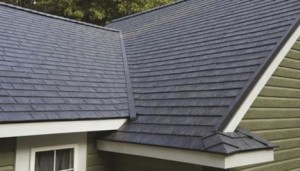
What’s in a Roof? The 411 on Shingles

A good coat of shingles on your home’s roof will protect not only from weather, but from a great deal of other common home ailments.
But they can’t do it alone.
The complete protection of your home, family and possessions from the elements comes from a quality, properly installed roofing system.
It’s a team effort.
Before you go shingle shopping, understand the various parts that make up your roof and what kind of shingles will be compatible.
“An effective whole roof system is a combination of performance and proper installation,” explains Jeff Frantz, Washington, D.C. metro area Territory Manager for CertainTeed, a popular roofing product manufacturer.
“Also pay close attention to proper ventilation and passive airflow using intake and exhaust. Think about the best components, the best contractor and the best warranties.”
When any of the main elements of a typical roof are damaged, missing, or reaching the end of their lifespan, you risk damage to the other protective layers of your roof. Read up on these MVP’s Here.

Why use a shingle?
From home insulation to rot prevention, shingles are one of the hardest working elements of your home, but there is a whole lot more to them than a bit of sandpaper. Shingles are the outermost roofing material and are the first line of defense in the whole roof system against the elements.
While shingles definitely add curb appeal and a big dose of home equity, it’s good to know what you’re paying for with the huge variety of styles and materials available today. Singles are available in metal, ceramic, slate, asphalt, and wood, but you’ll get the best bang for your buck from asphalt.
The affordability of asphalt shingles is unmatched. Per square (a square is 100 feet of surface area, which is how roofing contractors measure a roof), the cost of an asphalt roof is over 90% less than slate and over 80% less than a metal roof.
The Asphalt Roofing Manufacturers Association reports that the roofs of four out of five houses in the U.S. use asphalt shingles to protect and adorn their homes.
What exactly is an asphalt shingle?
Asphalt roofing shingles are rectangular sections of shingle made of a base mat, asphalt, granules and back-surfacing. You can learn the ins and outs of each material Here and all the different asphalt styles, but most shoppers are more interested in the aesthetic of how asphalt shingles will look on their house.

It’s all about the look.
A cedar shake roof is a roof made from pieces of hand-split cedar wood that are individually applied to a roof base by a skilled craftsman. The splitting process gives a cedar-shake roof added thickness, uniqueness, and aesthetic dimensions that are highly desirable. But because they are made of cedar and are handcrafted, they are incredibly expensive.
Knowing our affinity for this look, asphalt shingle companies started making a dimensional asphalt shingle back in the early 1970’s that gave the look of cedar shakes, and their look and longevity have only gotten better since then.
Most new and replacement roofs that you see today are constructed with shake-style shingles. The homes with roofs nearing replacement age commonly have the basic 3-tab shingles.
Shake on the style.
Shake-style. Architectural. Dimensional. Three names for the same good looking product. In terms of style, color, and selection, shake-style asphalt cannot be beaten for the price. The up charge for this thicker shingle is generally worth it, especially in a buyer’s real estate market.
When you’re shopping for shake-style asphalt shingles, the best performing ones on the market will have triple laminate construction. Three layers provide added protection from heavy winds.
Generally rated for wind speeds in excess of 100 miles an hour, shake-style shingles are an excellent choice for regions prone to severe weather. Some companies even offer lifetime limited and 50-year transferable warranties with shake-style shingles.
Tried and true asphalt shingle.
At face value, the lowest price in the market is going to be your basic 3-tab asphalt. It is the most economical choice and still has the high durability that asphalt is known for. Regular asphalt comes in at about 8-10% cheaper than their shake-style counterparts.
Most of these basic asphalt shingles are warranted to perform for 20, 25 or 30 years, depending on brand and style. Most carry the same UL Class A fire resistance rating as dimensional shingles because they’re generally made of the same materials.
Their wind resistance ratings are often less than shake-style options. If you don’t live in a region prone to strong winds (gusts greater than 60 or 70 miles per hour), this may not be a deal-breaker for you.
Case in short:
When considering performance, definitely talk with a roofing specialist to determine the roofing shingles and products that are right for your region and home. The specialist should provide you with product specifications and warranty information to help you make the most informed decision about your investment.
Another factor to consider is the extended warranty that shake-style shingles offer. If you have to replace a 3-tab roof after 20 or 25 years, but your shake-style roof lasts for 50, then the shake-style roof saved you money in the long run.
Post by: Janet Beckley, Long Roofing

